Grass In-depth Research Report: DePIN's Outstanding Star, Expanding AI Data Bank

Reprinted from panewslab
04/15/2025·24DKey points TL; DR
- How did Grass stand out among a number of DePIN projects?
The core factor is zero-track without thresholds, users are the cornerstone, and other factors are leverage .
Grass breaks through DePIN intra-volume with the dual engine of "technology + mode" - through zero-knowledge proof and Solana Layer2 architecture, ensuring data authenticity and solving the pain points of "dirty data" in the AI industry; at the same time, using the "bandwidth mining → points incentive" model to convert 2.5 million users into data nodes, forming a supply-side crushing advantage.
Coupled with factors such as the surge in demand for AI data, the popularity of Solana and DePIN, and reasonable operating methods, it has created the position of the leader in DePIN in AI data.
- What factors need to be paid attention to when Grass’ subsequent participation?
In the short term, the implementation of technology : whether the decentralized transition can be successful in 2025;
Medium-term demand verification : AI enterprise procurement data scale;
Long-term compliance game : data privacy and ownership rules.
The biggest risk at present is that " token carnival covers up the demand vacuum " - if AI customer orders cannot be increased in the future, the perfect commercial flywheel may degenerate from the positive cycle of "data-capital" to a supply-side bubble.
The report is about 12,000 words, and the estimated reading time is 10 minutes (This report is produced by DePINOne Labs. Please contact us for reprinting)
1. Industry background
When DePIN 's computing power democratization encountered the data dilemma of AI, a data equality movement quietly broke out.
DePIN integrates global idle resources (computing power, storage, bandwidth) through the token economy to build a distributed infrastructure network; at the same time, the AI industry is facing structural shortages in data, monopoly of giants, privacy disputes and island barriers, resulting in 80% of the data value not being released.
The essence of future AI competition is the dual game between data acquisition efficiency and ethical compliance, and DePIN provides the technical optimal solution.
Grass' subversiveness lies in the fusion of these two.
1.1 DePIN: A global paradigm for refactoring infrastructure
Definition and core logic
In recent years, with the maturity of blockchain technology and the rise of Web3 concepts, all walks of life are exploring the path of decentralization. DePIN is exactly what this trend reflects in the infrastructure field. DePIN (full name Decentralized Physical Infrastructure Networks) is a new economic model that integrates globally distributed physical resources (such as computing power, storage, bandwidth, energy, etc.) through blockchain technology.
Its core logic is: to drive the community to contribute idle resources through token incentives, build a decentralized infrastructure network, and replace the high-cost and low-efficiency model of traditional centralized service providers.
Industry driving force
Compared with the centralized model, the decentralized transformation of physical infrastructure has greater advantages in cost structure, governance model, network resilience, and ecological scalability.
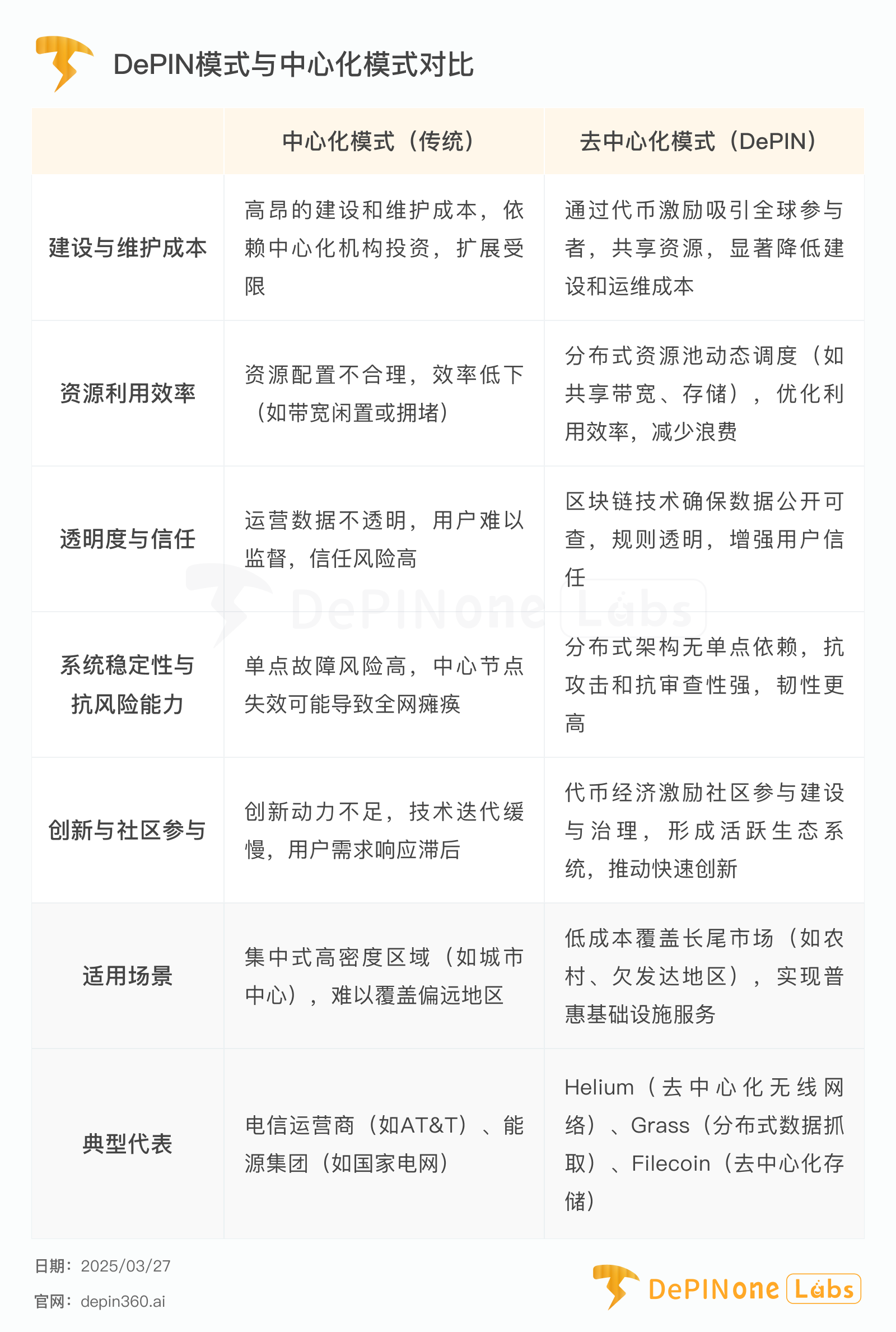
Subdistricts and typical cases
According to Messari's definition, DePIN covers two categories : physical infrastructure (such as wireless networks, energy networks) and digital resource networks (such as storage and computing) , and achieves supply and demand matching and incentive mechanisms through blockchain technology.
- Physical infrastructure : represented by Helium (decentralized wireless network), a global communication network is built through the community deployment of hotspot devices;
- Digital resource network : including Filecoin (decentralized storage), Aethir (distributed computing), etc., forming a sharing economy model by integrating idle resources.
Market potential
According to Messari data, as of 2024, the global number of DePIN devices has exceeded 13 million, with a market size of US$50 billion, but the penetration rate is less than 0.1%, and it is expected to grow by 100-1,000 times in the next ten years.
In 2024, the total market value of DePIN track reached US$50 billion, covering more than 350 projects, with an annual growth rate of more than 35%.
Its core driving force lies in the bilateral effects of improving resource efficiency (such as the utilization of idle bandwidth) and demand explosion (such as the demand for computing power and data by AI).
Of course, the scalability, data privacy and security verification of decentralized networks are still key challenges in the development of DePIN.
1.2 AI data demand: explosive growth and structural contradictions
" Data is the new oil"
The acquisition and processing of AI data is the core driving force for the development of artificial intelligence, especially when training large language models (such as GPT) and generative neural networks (such as MidJourney).
The performance and effectiveness of AI models depend largely on the quality and quantity of training data. High-quality, diverse and geographically representative data are critical to the performance of AI models.
Data demand scale and characteristics
- Episode leap : Taking GPT-4 as an example, training requires more than 45TB of text data, and the iteration speed of generative AI requires real-time update and diversification of data;
- Cost proportion : In AI development, data collection, cleaning and labeling costs account for more than 40% of the total budget, becoming the core bottleneck of commercialization;
- Scenario differentiation : Autonomous driving requires high-precision sensor data, medical AI relies on a case library of privacy and compliance, and social AI relies on user behavior data.
Pain points for traditional data supply
- Data barriers : Giants such as core enterprises/main entities control a wide range of data sources, and small and medium-sized developers face high thresholds and unfair pricing;
- Data islands: Data is often scattered in the hands of different institutions and enterprises, and data sharing and circulation face many obstacles, resulting in data resources being unable to be fully utilized.
- Data privacy : Data collection often involves privacy and copyright disputes, such as the Reddit API charging incident that triggers developers' protests;
- Inefficient circulation : data silos and lack of standardization lead to repeated collection, with global data utilization rate less than 20%;
- Value Chain Interruption: Individual Contributors who create data cannot profit from subsequent use of data.
DePIN 's breakthrough path
- Distributed data collection : crawl public data (such as social media, public databases) through node networks, reduce the cost of data collection, and improve the efficiency and scale of data collection;
- Improve data quality and diversity : Through the DePIN incentive mechanism, more participants can be attracted to contribute data, thereby improving the quality and diversity of data and improving the generalization ability of AI models.
- Decentralized cleaning and labeling : the community collaborates on data preprocessing, and combines zero-knowledge proof (ZK) to ensure data authenticity;
- Tokenized incentive closed loop : Data contributors receive token rewards, and demanders purchase structured data sets with tokens to form direct matching of supply and demand
The Grass project is located at the intersection of DePIN and the AI data industry . It innovatively applies the DePIN concept to the field of AI data acquisition and builds a decentralized data grabbing network to provide a more economical, efficient and reliable data source for AI model training.
In the following chapters, we will conduct in-depth analysis of the specific mechanisms, technical characteristics, application scenarios and future development prospects of the Grass project.
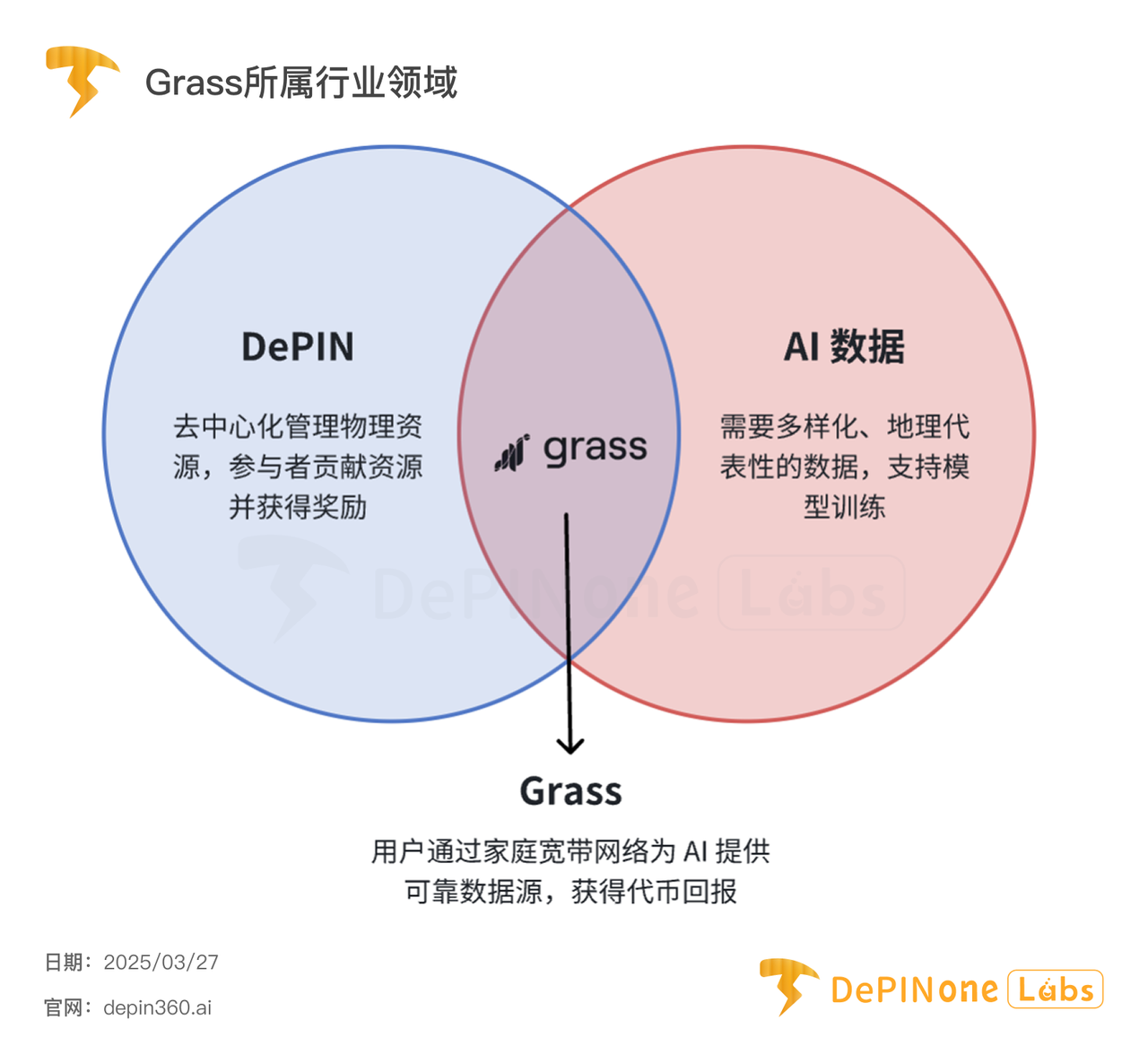
2. Basic project information
Grass ' rapid expansion is inseparable from its extremely low threshold for participation. Let every user become a 'miner' of AI data and exchange idle bandwidth for future dividends.
Grass builds a decentralized data grabbing network through the DePIN architecture, providing AI training with a cost-effective and highly diverse data source. Users only need to install a client to contribute bandwidth to obtain token rewards - it attracts more than 2.5 million nodes in one year of online launch, and the token's initial public offering increased by more than 5 times, verifying its business logic.
The project has been bets from top capital such as Polychain and Hack VC, and relies on Solana's high-performance chain to achieve data rights confirmation and circulation.
The current team anonymity is still controversial, and the progress of decentralization of data processing needs to be followed.
2.1 Business scope
Grass is a DePIN project that collects and validates Internet data through unused bandwidth of user devices, especially powers artificial intelligence (AI) development.
Its core is through a residential proxy network that allows companies to use users' Internet connections to access and crawl Internet data from different geographical locations, which is very useful for AI model training that requires diversified and geographically representative data .
- Problem solved : Traditional network crawling is usually done by centralized systems, is inefficient and prone to errors or biases. Grass aims to provide reliable and verified Internet data through decentralized methods, and the data provided by decentralized users is naturally diverse, published in multiple regions, and real-time.
- Vision and Mission : Grass’ vision is to create a decentralized internet data layer where data is collected, verified and structured in a way that is minimized by trust. Its mission is to give users the power to contribute to the data layer and to incentivize participation through reward mechanisms.
- How to participate in users : Users only need three steps to start: access the Grass official website, install the extension/client, connect and start earning Grass Points. This way of contributing bandwidth to earn rewards provides ordinary users with an opportunity to share the dividends of AI growth.
In summary, Grass' key features and advantages are: the cost of crawling data in a decentralized network is that it has low data cost and richer data diversity; users earn rewards by contributing bandwidth to achieve data value regression; and use blockchain technology to verify data to ensure data transparency and reliability.
2.2 Development history
Concept Stage: In mid-2022, the project was proposed by Wynd Labs.
Development stage: Product construction began in early 2023, marking the project entering the actual development stage.
Seed Series: In 2023, Grass completed a $3.5 million seed Series led by Polychain Capital and Tribe Capital, totaling $4.5 million (including the seed front-round led by No Limit Holdings).
User Testing: At the end of 2023, the Chrome browser extension was launched to start user testing and attract early users to participate.
Milestone: In April 2024, the project announced that more than 2 million connected node devices are growing rapidly. According to DePIN Scan, as of March 2025, its active users had exceeded 2.5 million.
First airdrop: On October 21, 2024, the first airdrop was announced, with 100 million GRASS tokens (10% total supply) being allocated to reward early users.
Online exchanges: On October 28, 2024, the price of OKX and other exchanges was launched. The price in the 10-day online market has risen by about 5 times, up by about 5 times.
Current status: The project continues to expand, and the second phase of user hang-up incentive is underway; Android and iPhone mobile apps are planned to be launched to increase network size and user engagement.
2.3 Team situation
According to Rootdata data, Grass is developed by Wynd Labs and founded by Andrej Radonjic, CEO of Wynd Labs, with a Master of Science in Mathematics and Statistics from York University and a Bachelor of Science in Engineering Physics from McMaster University.
The team members are all from Wynd Labs, focusing on blockchain and AI technology development, and have experience in related fields. However, the specific member information has not been widely disclosed, and only Radonjic's identity has been disclosed.
According to Tracxn, Wynd Labs was founded in 2022, and its core product is Grass.
The team background shows professional capabilities in the fields of blockchain and AI, but insufficient information transparency may affect the trust of investors and users. Radonjic 's experience provides credibility for the project, but the anonymity of other members may raise concerns.
2.4 Financing and important partners
Investors and Support
Seed Round : Completed a $3.5 million seed round in 2023, led by Polychain Capital and Tribe Capital. According to Rootdata, total funding after the seed round reached $4.5 million, including the seed front-round led by No Limit Holdings.
Series A : Completed Series A in September 2024, led by HackVC, with participation from Polychain, Delphi, Lattice and Brevan Howard, the amount was not disclosed.
Investor support : HackVC, Polychain, Delphi, Lattice and Brevan Howard are all well-known investors in the industry. Getting their support also shows how well the project is recognized within the industry.
Partners
Blockchain platform : Built based on Solana network, the project takes advantage of Solana's high performance and scalability.
There is no clear mention of specific collaborations with AI companies or other projects, but the Solana network’s ecosystem may provide opportunities for future collaboration.
3. Project technical analysis
Grass attempts to redistribute data value from big tech companies to average users.
The node network, ZKP processing innovation, and data ledger in the Grass technical architecture constitute a closed-loop workflow , from collection, verification to delivery, decentralization, which better supports its decentralization vision.
However, the current centralized operation needs to be solved, and whether the technology implementation can be implemented smoothly still needs to be tracked.
3.1 Core technical architecture: Sovereign Data Rollup
Grass is building the first sovereign data summary. It simplifies data procurement and conversion through a globally distributed network of Grass nodes, thus enabling common structured web data access to AI. The infrastructure is powered by dedicated data Rollup on Solana and is designed to manage the full lifecycle of data—source, processing, validation, and datasets. The architecture revolves around the following components:
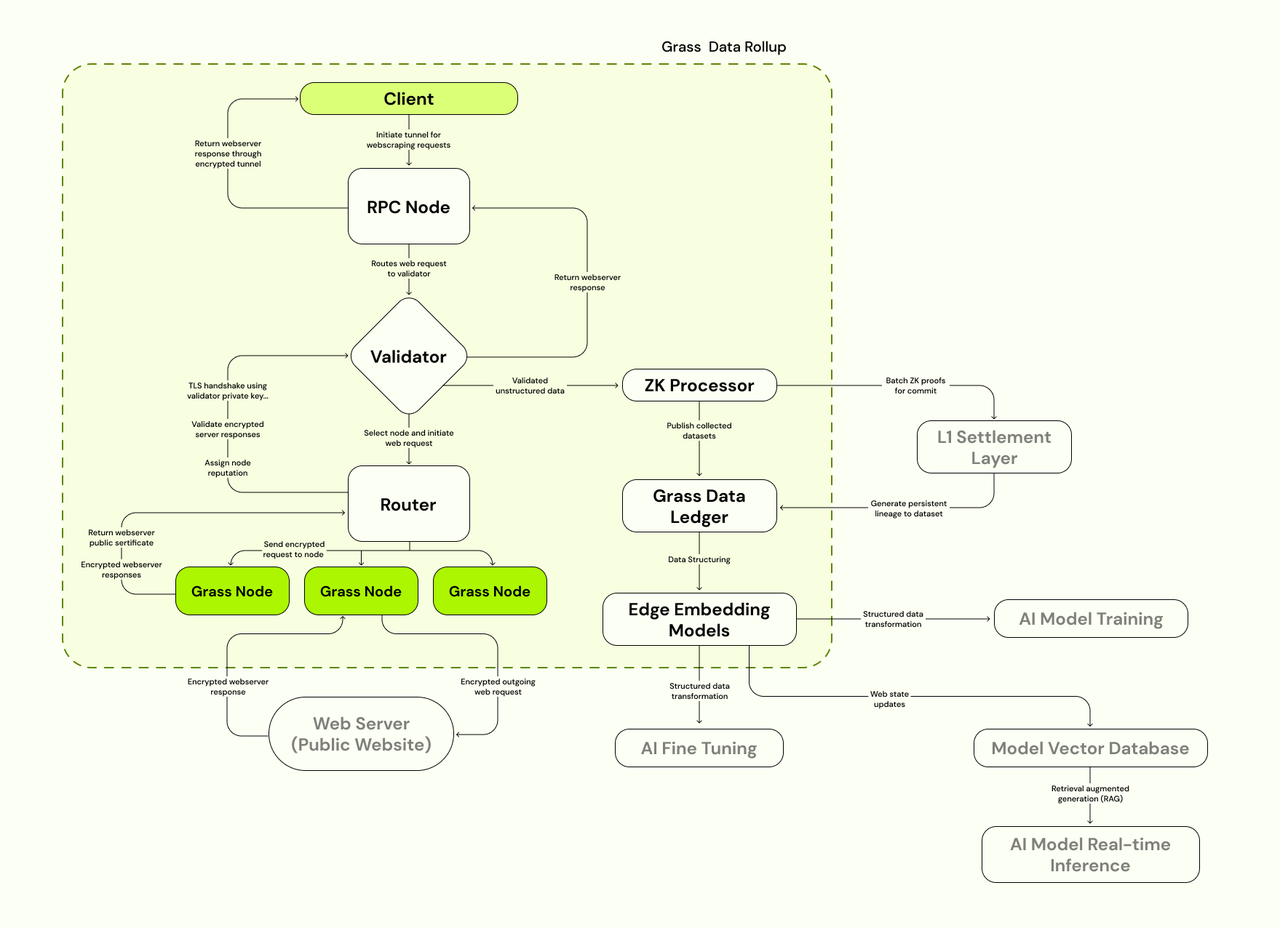
Disassemble the core components of Grass' technical architecture:
Node network
- It consists of three layers: validator, router, and Grass node.
- Users share unused Internet bandwidth by installing browser extensions/desktop applications, form Grass nodes, and form a global distributed network. Currently, Grass has more than 2.5 million nodes, covering more than 190 countries, and crawling about 100TB of data every day, providing a diversified and geographically representative data source for AI development.
- The Grass router connects the Grass node to the validator. The router is responsible for the node network and relay bandwidth.
- Verifiers receive, verify and batch process transactions distributed by routers. They then generate ZK proofs to check session data on the chain. At the current stage, data collection is processed by a centralized system, and it is planned to be decentralized through the Layer 2 network in the future.
Zero Knowledge Proof (ZK) Processor
- Grass uses zero-knowledge proof to verify data sources to ensure data privacy and integrity. The ZK processor generates on-chain proofs, validating data sources and tracking their life cycles, enhancing data credibility. As Donovan Choy said, ZKP's application solves the trust problem of traditional network crawling and provides transparency to the AI data market.
Data ledger
- Grass Data Ledger is the link between the crawled data and the L1 settlement layer. Data is recorded on the blockchain through Grass' Layer 2 network (based on Solana), forming a "Sovereign Data Rollup". This ensures data transparency and traceability, enabling AI developers to efficiently access structured datasets.
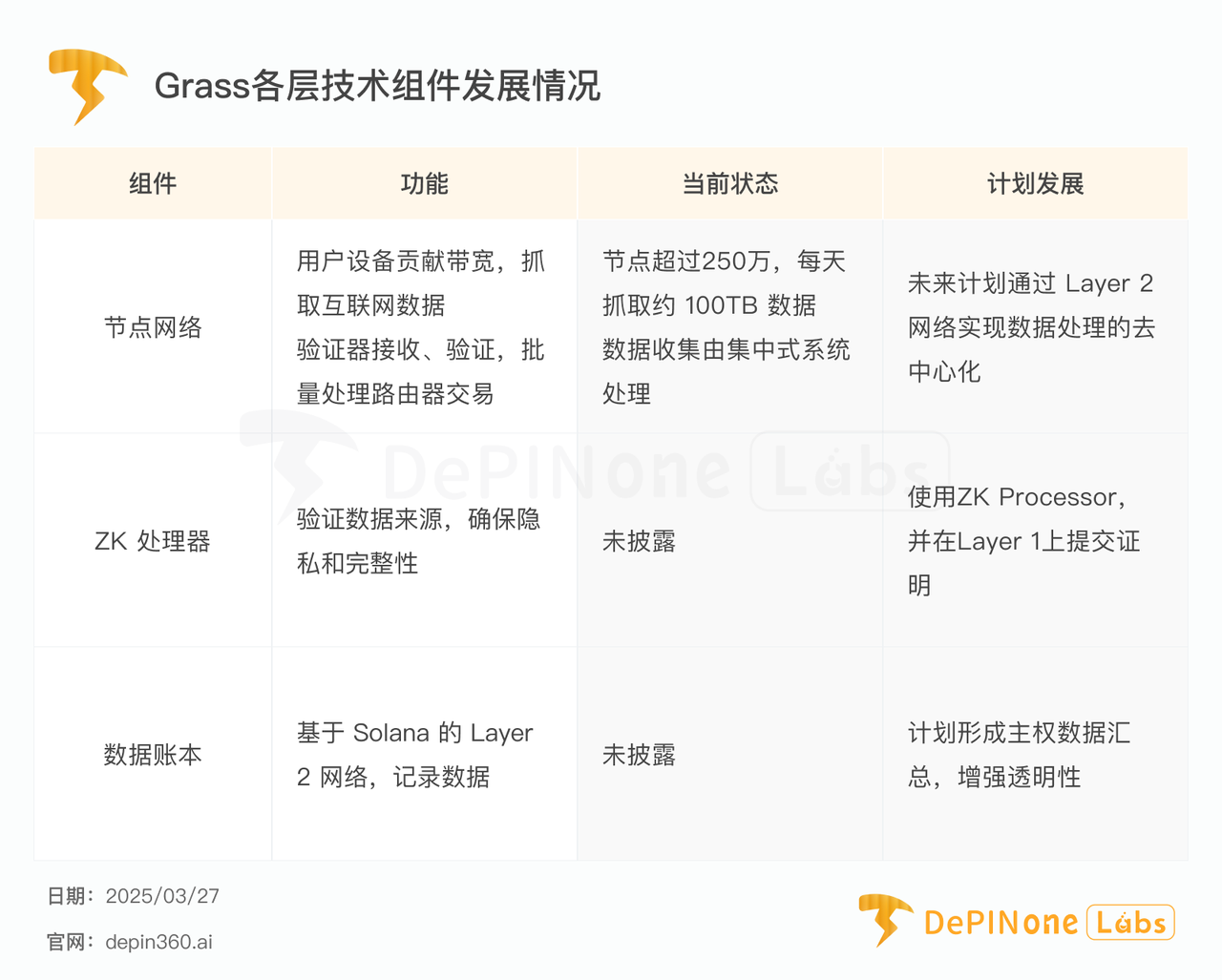
3.2 Technical breakthroughs and rationality
In the architecture disclosed by Grass, each layer has technical highlights.
- The application of the DePIN concept to network data crawling fills the decentralized gap in AI data collection. This is the first large-scale application of DePIN in the field of data infrastructure.
- Using ZKP to verify data sources solves the privacy and trust issues of traditional centralized crawling, which is one of its technical highlights.
- Build a Layer 2 network to handle high-throughput data transactions, taking advantage of Solana's low cost and high efficiency benefits.
- In addition, Grass plans to launch the Live Context Retrieval technology in the first quarter of 2025, which will further enhance its ability to provide real-time data for time-sensitive AI models.
Grass' technical design is not limited to single-level highlights, but rather forms a complete solution that supports its technological vision.
Grass’ vision is to create a decentralized Internet data layer that provides reliable and trusted data sources for AI development.
- The scale of the node network can support the provision of its diversified data sources, which is in line with the principles of decentralization and democratization.
- ZKP's privacy protection capabilities ensure user data security and enhance user trust.
- The deployment plan of the Layer 2 network will improve network efficiency and scalability, supporting large-scale data processing needs.
However, it is still in the beta phase, and data collection is processed by a centralized system, which may limit its fully decentralized implementation. Pay attention to future deployment progress of Layer 2 networks to ensure the realization of the vision.
4. Business model flywheel
Grass presents a nearly perfect commercial flywheel. The flywheel can rotate and supply, but cannot bear demand.
Supply side : 2.5 million nodes capture 100TB of raw data per day, and after ZK verification, it forms a compliant data set;
Demand side : AI companies purchase on demand, and earnings feed back to the ecosystem through tokens, completing the alchemy of "bandwidth → data → cash flow". (The demand side has not yet been verified - whether AI companies will pay for decentralized data is still to be verified by large-> scale orders.)
4.1 Closed loop of business model: Make full use of token incentives
Grass' business model can be summarized as: users contribute bandwidth to obtain Grass Points rewards → scrape public data resources on web pages → AI enterprise purchase data → Revenue forms a closed loop through token allocation.
User contribute bandwidth
- Users share bandwidth by installing extensions/desktop applications, and recommend friends to provide 20% direct rewards and 2nd and 3rd level 10% and 5% rewards.
- Grass Points is calculated based on bandwidth usage, geographical location and other factors, and plans to add reward methods based on milestones and online time in the future.
Scrape the public data resources of the web page
- Grass nodes utilize unused bandwidth and relay traffic so that the network can crawl public Web data.
- Grass' residential agency network provides AI developers with diverse and geographically representative data sources .
AI enterprise purchase data :
- AI companies purchase structured datasets through the Grass network for model training.
Revenue closed loop :
- Network revenue is distributed to users through GRASS tokens, forming a sustainable incentive mechanism. Grass Points can be converted into GRASS tokens with a total supply of 1 billion pieces. The community allocates 300 million pieces of tokens for future incentives and router rewards to ensure long-term development.
- Tokens can be used to stake to routers to support network traffic and earn rewards through network activities.
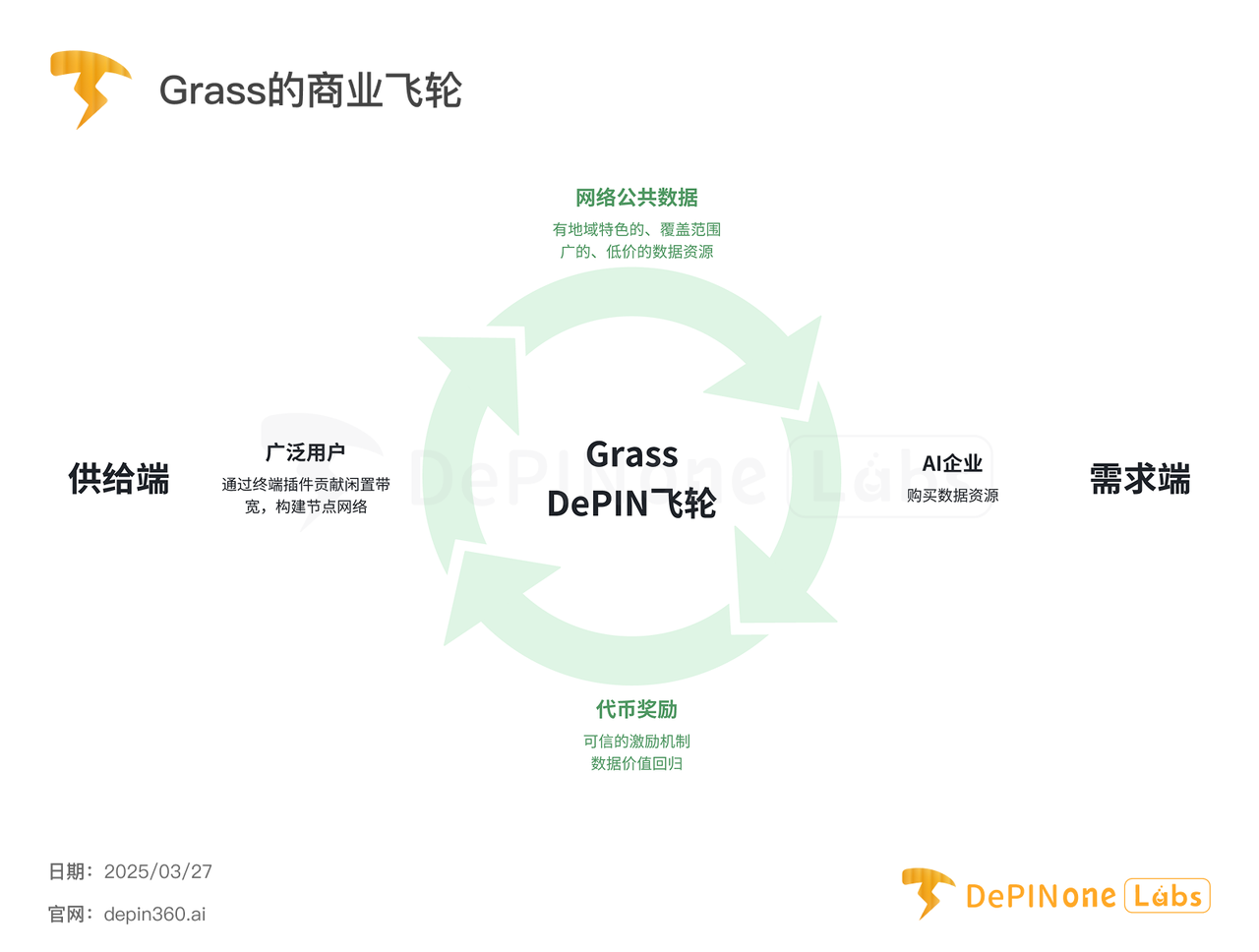
4.2 Model innovation and success
The biggest innovation in Grass' business model is to form a positive feedback loop through recommendation systems and token rewards. Of course, this is what most DePIN projects are in common.
Grass attempts to redistribute data value from big tech companies to average users. Apply the DePIN model to the AI data market, create passive revenue opportunities for users, and subvert the profit model of traditional centralized proxy networks (such as Luminati and Honeygain).
The success of its business model is inseparable from any of the following factors:
- High user engagement : As of March 2025, there were more than 2.5 million users, showing ease of use and community appeal.
- Market fit : AI data demand is growing rapidly, and Grass fills the gap in the decentralized data layer, in line with industry trends.
- Economic incentives : Through token rewards and recommendation systems, a positive feedback loop is formed to attract more users to participate.
4.3 Flywheel Risk
Consistent with most DePIN projects, the weakness of the supply and demand commercial flywheel is on the demand side.
The token incentive model makes it easier for projects to accumulate on the supply side, but we have not seen the official results given by the official whether the massive amount of data can be cleaned and processed well, making it a standard product that the B-side is willing to pay for.
In the design of the Grass project, they will participate in the two aspects of providing AI data sets and analytical preparation. Let AI companies that require extensive user text data (or businesses that find it useful to track media sentiment) buy from users through Grass as an intermediary, rather than from large tech companies.
We look forward to further seeing the realization of demand link delivery in the future.
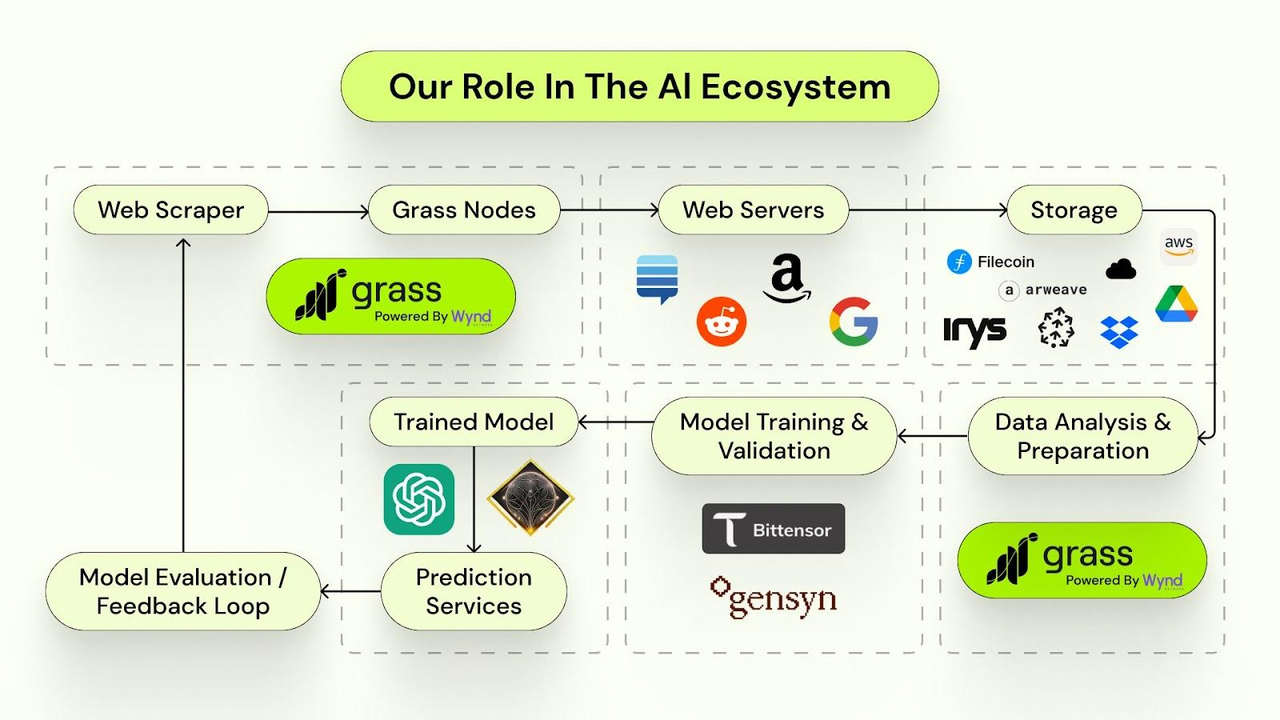
Another risk that needs to be noted is that Grass' model provides users with the opportunity to share AI growth dividends, but it is necessary to pay attention to data privacy risks and execution of decentralized transitions.
5. Economic Model
When the capital feast fades, is DePIN tokens a hard currency of AI data or a bargaining chip that passes flowers?
The surge in Grass' price is mainly due to the large user base, exchange listing and the hot sentiment in the DePIN market, coupled with operational user incentives and community participation, rapidly expanding the user base.
But it is necessary to pay attention to the impact of early investor unlocking and airdrop disputes, as well as the demand-side verification whether long-term development issues can be supported.
5.1 Token Model
Grass' token economic model is based on its native token $GRASS , with a total supply of fixed 1 billion.
According to its GitBook documentation, the token allocation is as follows:
- Community: 30% (300 million) , including:
- Future incentives: 170 million for retrospective programs to reward early contributors and developers who create valuable content or tools for the web.
- Router reward: 30 million coins, used to incentivize the router to support network traffic and reduce latency.
- First airdrop: 100 million (10% total supply), allocated on October 28, 2024, rewarding more than 2.5 million users.
- Foundation and ecosystem growth: 22.8% (228 million pieces) , held by the Foundation, to support network operations, upgrades, partnerships and R&D.
- Early investors: 25.2% (252 million) , with a 1-year lock-up period and a 1-year vesting period, ensuring long-term commitment.
- Team: 22% (220 million) , with a 1-year lock-up period and a 3-year vesting period, which inspires the team to develop in the long term.
Token uses include:
- Rewards: Incentive users to contribute bandwidth and recommend others.
- Staking: Users can pledge GRASS tokens to the router, support network traffic, earn rewards, no minimum period, and the unlocking period is 7 days.
- Governance: Token holders can participate in network decision-making, including voting proposals and partner choices.
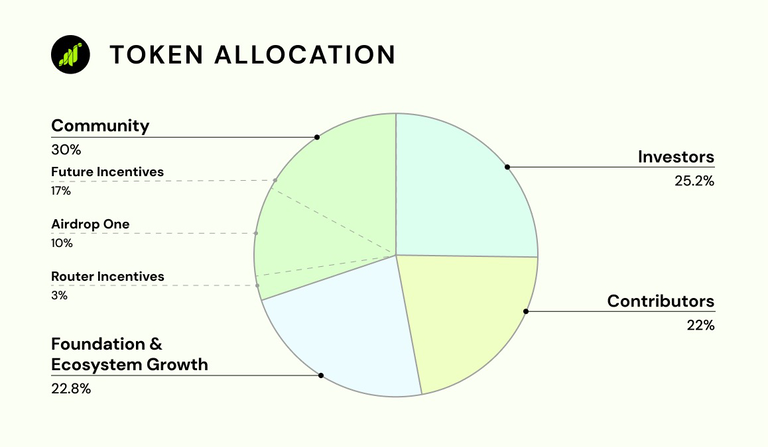
5.2 Token Market Analysis
The Grass project's token $GRASS was issued through its first airdrop on October 28, 2024, with an initial price of approximately USD 0.64.
Subsequently, the coin price reached an all-time high of US$3.90 on November 7, 2024, an increase of more than 500%, mainly due to the airdrop attracting a large number of users and listing on major exchanges such as Bybit, Gate.io, and Bitget. During the next two months, the currency price continued to fluctuate between US$2-4, and the currency price was relative.
Prices fell at the beginning of 2025, and there was another wave of rebound in early March.
As of March 28, 2025, the GRASS token price was approximately US$1.6 million, with a market value of approximately US$450 million, and a 24-hour trading volume of US$51.63 million (CoinMarketCap). The circulating supply is 243.905 million, indicating that some tokens have not been unlocked yet.
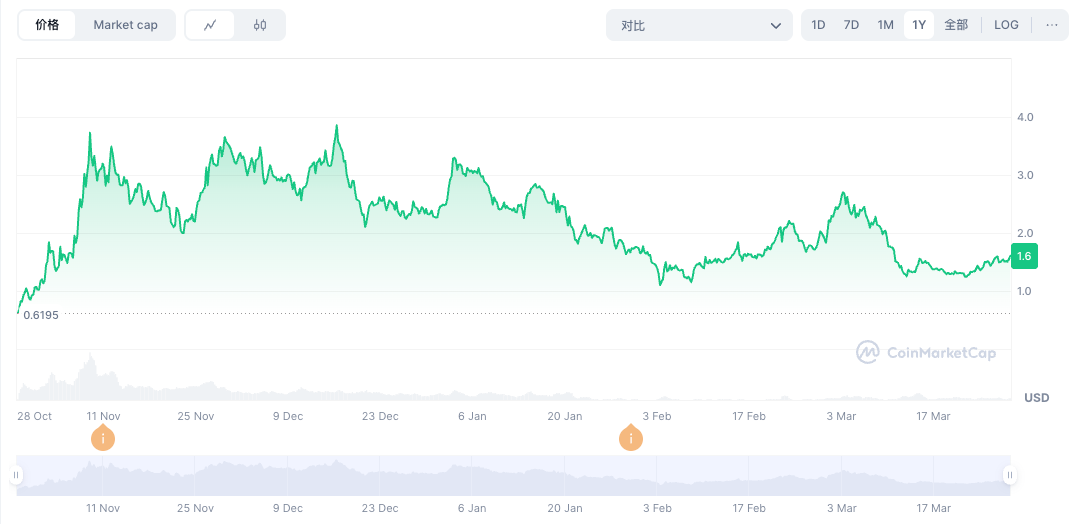
Compared with other projects in the Shanghai Stock Exchange at the same time, Grass 's coin price is undoubtedly the one with a very impressive performance: it doubled 5 times in 10 days of launch; it continued to maintain a relatively stable high price for half a year.
Reasons for the surge in listing prices
GRASS tokens have experienced significant early surges since their issuance, especially in October and November 2024, reaching a maximum of USD 3.90 (CoinMarketCap), with key drivers including:
- Huge user base: The first airdrop on October 28, 2024 allocated 100 million tokens, covering more than 2.5 million users , greatly increasing market liquidity.
- The first online DePIN project token: Compared with the high threshold for participation in traditional DePIN projects, the network hang-up project led by Grass greatly lowers the user's participation threshold. Among these projects, Grass is the first to conduct TGE, and it also breaks the deadlock of ICO without DePIN project for a long time.
- Exchange Listing: Tokens are listed on major exchanges such as Bybit, Gate.io and Bitget, increasing trading volume and investor interest.
- Industry Market Sentiment: The craze for DePIN and AI-related projects has driven investor confidence, especially in the fourth quarter of 2024. CryptoRank.io notes that the activity of the Solana ecosystem has also contributed to price increases.
- Pledge mechanism: Grass' pledge mechanism provides users with generous benefits. By the end of 2024, the total amount of user pledged 27 million GRASS, accounting for 35% of the total supply. Compared with the industry average APR, Grass' annualized yield of 43.69% undoubtedly attracted the attention of many investors. With the increase in pledge demand, the market's optimistic expectations for Grass' future growth have become increasingly obvious.
Operational facilitators
Grass's operating strategy also plays a key role in price maintenance, and its specific benefits include:
- User incentive mechanism: Rapidly expand the user base through recommendation systems (20% direct reward, 2nd and 3rd 10% and 5%), with more than 2.5 million users as of March 2025.
- Community Engagement: Active community activities and transparent progress updates have enhanced market confidence, such as continuing to share milestones through X posts.
- Technology progress and market expectations: Plans to launch mobile apps for Android and iPhone, as well as the deployment of the Layer 2 network, attract more investors. Bitget News mentioned that the release of the 2025 roadmap further boosted prices.
Development risks
- The current currency price is driven by supply-side fanaticism (low circulation plate + exchange online effect), rather than real AI data procurement demand;
- The false prosperity of pledged APY up to 68% is actually the hidden cost of token inflation;
- The 47.2% token is held by the team and early investors (220 million + 252 million), and will be gradually unlocked from 2025. If the demand side does not explode simultaneously, it may trigger selling pressure.
6. Project Ecological Analysis
Grass is a leading position in AI data and DePIN projects based on idle networks, with a clear competitive advantage.
The DePIN and AI data fields have great potential and broad space for industry growth; the Solana ecosystem supports its expansion.
6.1 Horizontal comparison (competitive analysis)
According to incomplete statistics, there are currently more than 600 projects in the DePIN industry, with a total market value of more than US$16 billion. In the three months of the end of 2024, Grass has been ranked first in Rootdata's DePIN project popularity list.
We cannot list too many projects one by one. Here we select 3 representative projects for comparison: Filecoin, the leading project in the computing field, Helium, the leading project in the wireless transmission field, and Nodepay, the project closest to the Grass field and also completed TGE.
Filecoin: Filecoin provides decentralized storage, and users can rent unused storage space. It is based on the Filecoin blockchain and uses FIL tokens. As of March 5, 2025, there were approximately 1,500 active miners with a market capitalization of approximately US$2.5 billion.
Helium: Helium is a decentralized wireless network that mainly serves IoT devices. Users provide coverage by setting hotspots and use HNT tokens. As of March 5, 2025, there were more than 200,000 active hot spots and the market capitalization was approximately US$200 million.
Nodepay: Nodepay is a network hang-up platform where users can contribute bandwidth to support AI training, provide user feedback, and earn NC tokens. The market capitalization is about $10 million.
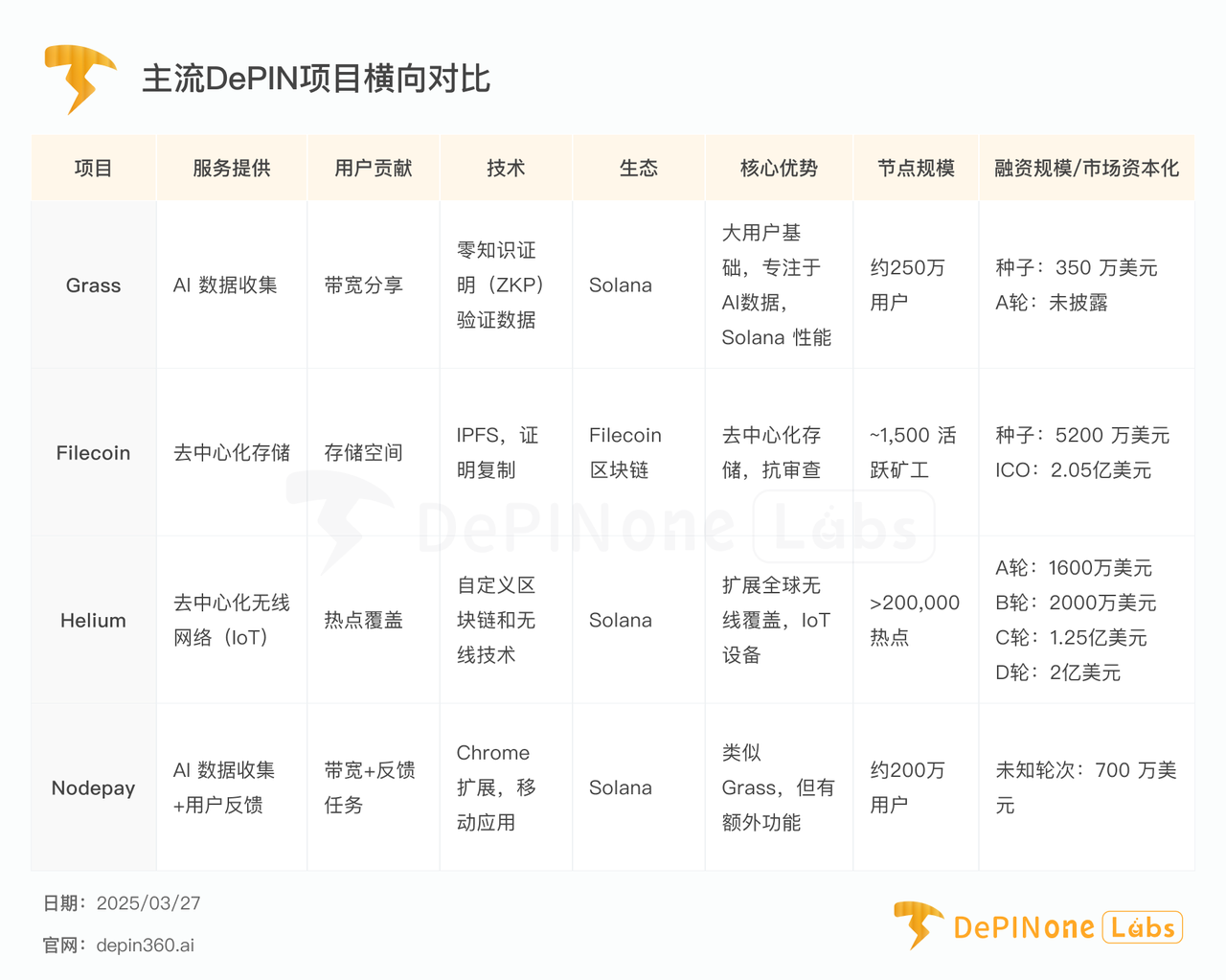
Service provision : Grass and Nodepay both focus on AI data collection, but Grass is more focused on bandwidth contribution, Nodepay increases user feedback functions; Filecoin provides storage services, Helium provides wireless network coverage, and the service field is obvious.
User contributions : Grass and Nodepay rely on bandwidth, Filecoin rely on storage space, Helium rely on hotspot settings, and user participation methods vary.
Technology : Grass uses ZKP and Solana Layer 2, technology is advanced; Filecoin uses IPFS and proof replication, Helium uses custom blockchain, and Nodepay technology is less disclosed.
Blockchain : Grass and Nodepay are based on Solana and have strong scalability; Filecoin and Helium each have independent blockchains.
Core advantages : Grass leads with its large user base and AI focus, Filecoin is censor-resistant, Helium is suitable for IoT, and Nodepay has varied functions but low technical coherence.
6.2 Vertical potential (industry space)
Growth potential of the DePIN and AI industries
The DePIN industry is growing rapidly, utilizing blockchain to manage physical infrastructure networks. According to HTX Research, there are 650 projects in 2023 with a total market value of US$35 billion, covering sub-fields such as storage, computing, and AI data collection.
Grass belongs to the AI subfield. According to DePIN Scan, there are 83 AI-related projects.
The AI data industry has huge demands, model training requires high-quality and diverse data, and traditional methods face privacy and bias issues. Decentralized data collection provides a more secure and privacy-protected data source to meet AI development needs. Research shows that the AI market is expected to reach trillions of dollars in the next few years, and data demand continues to grow.
DePIN+AI combines creating a decentralized and secure data collection method, Grass fills the gap in AI data infrastructure and captures about 90TB of data every day, in line with industry trends.
Scalability supported by Solana Eco
Grass is based on the Solana network, known for its high performance and scalability, and is ideal for DePIN applications. Solana's fast trading speed (thousands of transactions per second) and low fees support Grass to process high data volume transactions, which enhances its expansion potential.
There are also active communities and tools in the Solana ecosystem that support Grass development and integration, and the Layer 2 network plan further improves efficiency.
Currently, Solana is the main platform for DePIN activities. According to public data, there are about 78 DePIN projects on Solana (refer to statistics from platforms such as Messari and DePIN Scan as of 2024), covering multiple subfields such as wireless communications (such as Helium), computing resources (such as Render Network), geolocation (such as Hivemapper), cloud storage (such as GenesysGo SHDWDrive). Grass contributes 2.5 million equipment in the ecosystem.
At this stage, Grass has obtained tickets to the AI data revolution and is a preemptive ecological builder . However, the Matthew effect of the DePIN track has begun to appear, and some giants have gradually entered the market to replicate their models, and Grass needs to accelerate the establishment of barriers to data procurement agreements.
7. Future Outlook
Grass is at the peak of the cross wave of DePIN and AI, but the waves under his feet may be more urgent than expected.
The weak demand-side problem that DePIN projects generally face also occurs with Grass. The key question is whether an attractive commercial canvas can be put into practice.
7.1 Project development route
During the first founders’ workshop in 2025, Grass outlined several key initiatives for the coming year.
Key highlights of the Grass 2025 roadmap include multimodal search . Specifically, the platform plans to semantically enable AI models to search for insights from video, audio, and text data in real time. Grass also plans to adopt a new distribution approach that expands its reach through mobile and other platforms, thereby simplifying user access and engagement.
In addition, the platform will deprecate Chrome extensions and introduce more powerful and efficient desktop nodes. Additionally, it will introduce Horizontal Scaling, a new product that can further expand its capabilities to ensure sustained growth and innovation.
Another key highlight is the Sion Phase 1 results. The Grass platform is designed to improve network efficiency and achieve 60 times the speed of data retrieval.
“If you’re wondering — within the days after the first phase of Sion, network activity has been reduced to near zero so that our storage partners have time to catch up. No one had anticipated this level of capability so early. Exciting moments are coming,” Grass contributor and co-founder of Wynd Network Andrej Radonjic said recently.
Based on Grass' current technical foundation, ecological layout, market performance, and the specific action plan that has been disclosed by the official, we can summarize Grass' future development path into three parts: technology iteration, ecological expansion, and governance upgrade.
Technical iteration
- Node network lightweight and mobile deployment: It is planned to launch Android and iPhone mobile applications, allowing users to contribute idle bandwidth through their phones to expand their user base and participation. According to Bitget News, mobile apps are expected to be tested and released in the second half of 2025.
- Data Quality: Grass' 2025 roadmap includes the deployment of the Sovereign Data Rollup, which is expected to be completed in the fourth quarter.
- Decentralized Transition: Grass plans to complete the transition to fully decentralized by the end of 2025, deploying a Solana-based Layer 2 network, using Zero Knowledge Proof-of-Signature (ZKP) to verify data, ensuring privacy and security. This will make data collection and verification more decentralized, enhancing the trust and reliability of the network.
Ecological expansion
- Dataset Cooperation: Grass has created the VALID dataset in collaboration with Ontocord and LAION, which will be further developed. This multimodal collection of 30 million audio clips, images and text is the basis for AI model training and an important resource for developers.
- Partnerships: Grass plans to partner with AI companies and other stakeholders to expand the network’s usefulness and adoption and attract more data buyers
Governance upgrade
- User motivation optimization : Grass will optimize its user motivation system, including adjusting Grass Points' calculation and recommendation mechanism (20% direct reward, 2nd and 3rd level 10% and 5%) to enhance user engagement and retention.
- Community participation : The project will solve problems such as the first airdrop allocation in the past, rebuild community trust, and maintain long-term development through transparent communication and community activities. (The first airdrop caused dissatisfaction due to the Phantom wallet problem and needs to be repaired through subsequent updates)
Overall, Grass' future development path is clear, focusing on decentralization, user expansion and technology upgrades, which is in line with the growth trends of the DePIN and AI industries.
However, attention should be paid to the technical complexity of the decentralized transition and the challenges of community trust reconstruction. If the above plan can be successfully implemented, Grass will hopefully maintain its leader in AI data infrastructure.
7.2 Risks and Challenges
Model risk
Grass' business model collects data through users' contribution bandwidth and sells it to AI companies. The income is used to reward users and form a closed loop.
- If the demand side (data purchased by AI companies) is not implemented , Grass will not be able to generate enough revenue to reward users, and users may lose motivation to participate, and the network scale will shrink, which will affect the data collection ability and form a vicious cycle, and the ultimate model will not be sustainable.
- How Grass pricing data is not yet clear . If the pricing is too high, it may lose its competitiveness; if the pricing is too low, it may not cover the operating costs.
- Grass may lose market if new data collection technologies, such as synthetic data, replace residential agents .根据EnterpriseAI.news,合成数据正在兴起,可能减少对真实数据的需求。
Technical risks
去中心化过渡的复杂性
- 从集中式到去中心化的过渡涉及技术复杂性,可能面临扩展性、安全性和性能问题。Layer 2 网络的部署需确保高吞吐量和低延迟,任何技术故障可能导致网络中断。
- 研究表明,类似项目的去中心化过渡曾因扩展性问题导致用户体验下降,Grass 需谨慎管理。
数据质量与完整性
- 在去中心化网络中,数据由用户设备收集,需确保质量和完整性。任何数据偏见或恶意活动可能影响AI 开发者的信任。数据质量是所有DePIN 项目的核心挑战。
- ZKP 的实施需确保数据来源可追溯,但可能面临效率问题,影响处理速度。
ZKP 效率与成本
- 零知识证明的效率直接影响网络性能,研究表明,ZKP 在高数据量场景下可能增加计算成本,Grass 需优化ZKP 以平衡隐私和性能。
市场风险
竞争压力
- Grass 面临来自集中式数据提供商(如Luminati)和去中心化竞争者(如Nodepay)的竞争。替代项目可能提供更低成本或更丰富功能,吸引AI 开发者。
- 需持续创新以保持市场领先地位。
监管合规挑战
- 数据隐私法规(如GDPR)可能对去中心化数据收集提出更高要求,监管变化可能增加运营成本或限制某些活动。
- 研究表明,DePIN 项目需适应不同司法管辖区的监管环境,Grass 可能面临合规压力。
社区信任重建
- 首次空投分配因Phantom 钱包问题引发社区不满,需重建信任以维持用户参与度。
- 任何进一步的社区管理失误可能导致用户流失,影响长期发展。
代币经济管理
- 当前币价由供给端狂热驱动(低流通盘+交易所上线效应),而非真实AI数据采购需求。
- GRASS 代币的总供应量为10 亿枚,需管理分配以避免市场波动。早期投资者和团队解锁可能导致价格压力,需平衡用户激励和市场稳定性。
7.3 小结
Grass 在DePIN 和AI 数据领域展现出显著潜力,凭借技术创新、市场定位和庞大的用户基础占据先机,适合关注DePIN 和AI 趋势的投资者。当前阶段持续以低门槛的形式参与Grass仍是不错的选择。
但其技术落地和市场竞争风险需密切关注。重点关注 技术上去中心化愿景的实现、需求端实际交易的验证、移动应用推出后用户的持续增长 ,这些都是未来发展历程中的重要里程碑。如果上述问题可以一一实现,则Grass的长期价值依然值得期待。
** 特别声明:** DePINone Labs所有文章仅用于资讯和知识目的,不构成任何投资建议。
部分参考内容
- Gitbook of Grass https://grass-foundation.gitbook.io/grass-docs/introduction
- DePIN's Imperfect Present & Promising Future: A Deep Dive https://www.compound.vc/writing/depin (后续将转载并解读)
- Reshaping the data layer of AI with Grass https://blockworks.co/news/depin-grass-reshaping-ai-data-layer
- Grass DePIN Protocol Review: Data for AI and Monetization of Internet Connectivity https://medium.com/@alexanderallenme/grass-depin-protocol-review-data-for-ai-and-monetization-of-internet-connectivity-6b616f799134
- Grass Unveils 2025 Roadmap: What You Need To Know https://www.bitget.com/news/detail/12560604497754
- For AI that serves people, data curation DePINs hold the key | Opinion https://crypto.news/ai-that-serves-people-data-curation-depins-hold-key/

